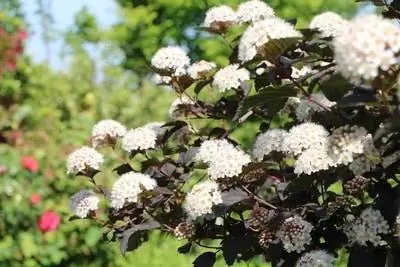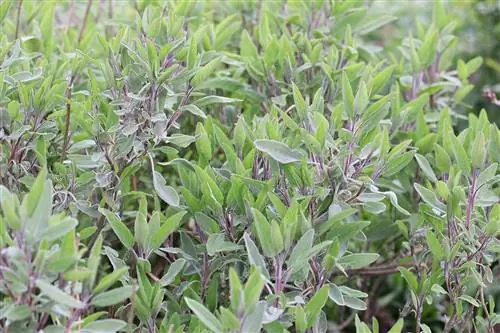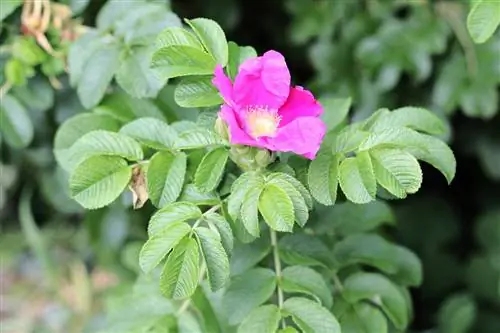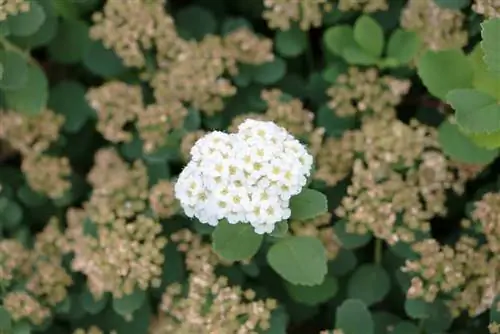- Author admin [email protected].
- Public 2023-12-17 03:39.
- Last modified 2025-01-24 12:45.
Physocarpus opulifolius 'Diabolo' is a very special variety of bladderwort with dark red, rough leaves, the shape of which is somewhat reminiscent of raspberry leaves. The shrub is quite insensitive to air pollution and is therefore often used in urban areas and on busy streets. As a wonderful contrast to the almost black leaves, which retain their dark color from spring to late summer, the bubble spar 'Diabolo' forms umbels of countless small white flowers from June onwards. In autumn, its leaves turn a bright orange before the plant sheds its leaves and goes into hibernation.
Short profile
- Botanical name: Physocarpus opulifolius 'Diabolo'
- special variety of snowball-leaved bubble spar
- other names: devil's bush, red pheasant spar, red-leaved bladderwort
- belongs to the rose family
- tight, upright growing bush
- Growth height: 2 to 2.5 meters
- Foliage: very dark red, almost black leaves
- orange-red in autumn
- Flowers: umbel-shaped, small white to light pink flowers
- Flowering period: June to July
- Fruits: bright red follicles (bubble shape)
- Decorative leaf shrub, flowering shrub
Occurrences
Physocarpus opulifolius, also known as the snowball-leaved bladderwort, is originally from eastern North America. As a rule, the upright-growing shrubs, which grow up to three meters high in their homeland, have green foliage. In our country, the bladderwort can occasionally be found in a very special variety as an ornamental plant or hedge plant in our gardens: as a red-leaved shrub called 'Diabolo'. Physocarpus opulifolius 'Diabolo' is also known as devil's bush, red pheasant spar or red-leaved bladder spar.
Location

The red-leaved bladderwort is one of the pleasantly undemanding garden inhabitants because it thrives in almost all garden soils, both in a sunny and a partially shaded location. However, one thing should be taken into account when it comes to the location: the sunnier Physocarpus opulifolius 'Diabolo' is, the more intense the red leaves will be. The shrub can be used to create wonderful accents in the garden, as this bubble spar looks particularly good in front of a white house wall or in combination with light-leaved neighboring plants. The plant is also well suited for large pots on the terrace or balcony, as it mainly grows vertically and therefore requires little space.
- Light requirements: sunny to partially shaded
- Soil: permeable, humic, nutrient-rich
- thrives in almost all garden soils
- pH value: both acidic and alkaline soils
Tip:
The ash maple flamingo (Acer negundo Flamingo), the white-colored dogwood (Cornus alba Sibirica Variegata), a golden wig bush (Cotinus coggygria Golden Spirit) or the wintergreen olive willow (Elaeagnus ebbingei Gilt Edge) with its yellow or variegated foliage.
Plants
As long as the ground is not frozen, the 'Diabolo' bladderwort can be planted all year round. The best time to plant is spring or autumn. In the case of very sandy and poor soils, it is recommended to incorporate compost or humus-rich potting soil in advance. If the garden soil tends to become waterlogged, drainage made of gravel or sand is necessary, as the red pheasant spar prefers well-drained soil. In addition, the planting hole should be dug a little more generously and sand or grit mixed into the humus-rich soil so that the water can seep away better.
- Time: Spring or Autumn
- Container plants all year round (except during frosts)
- Planting hole: double bale size
- Water the root ball thoroughly
- Remove the pot and loosen the bale
- place at ground level in the planting hole
- fill with humus soil
- come easy
- water again
Tip:
The advantages of autumn planting are that the bladderwort can form roots before winter and need to be watered less frequently due to the higher amounts of rainfall. These plants will be able to sprout better next spring.
Pouring
The red-leaved blister spar only needs additional irrigation water if it is persistently dry. Outdoor plants are somewhat more frugal and less sensitive to drought than potted plants, as they only have a limited supply of soil available. In warm or windy weather, the root ball of the plant in the pot should therefore be checked more often. If the surface is already very dry, it needs to be watered. It is always important to ensure that excess water can drain away easily, as the otherwise robust shrub does not tolerate waterlogging particularly well.
Fertilize
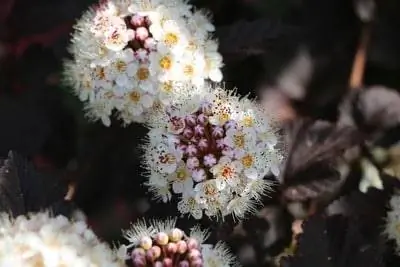
On nutrient-rich soil, the bladder spar rarely needs to be fertilized. The sandier and more permeable the garden soil is, the more often additional nutrients are necessary. For most outdoor plants, it is sufficient to incorporate some ripe compost into the garden soil in spring. On poor soils or for potted plants, it has proven useful to administer liquid fertilizer via irrigation water every 14 days. Alternatively, long-term fertilizers such as horn meal, horn shavings or fertilizer sticks can of course also be used. Fertilization is only carried out during the growth phase, i.e. between April and August. Later fertilizer applications prevent the young shoots from becoming woody. This makes the shrub susceptible to frost damage.
Cutting
Physocarpus opulifolius 'Diabolo' is one of the strong-growing shrubs that grow up to 25 cm tall per year. However, since the bladder spar is very easy to cut, it is not a problem to shorten it if necessary. However, there are a few rules to follow when cutting the tree, because incorrect cutting will disfigure the bushes forever. The optimal time for pruning the bush is very controversial, even among experts. In principle, the devil's bush can be cut all year round. Since the shrub forms its flowers on the previous year's wood, the next flower will not appear if the shoot tips are cut back in spring, autumn and winter. That's why many gardeners swear by cutting the 'Diabolo' bladderwort directly after flowering. The advantage of cutting in winter is that the shrub is easier to see without leaves. In summer, cuts heal faster.
Plant cutting
Since it takes a few weeks for the roots of the 'Diabolo' bladderwort to become anchored in the ground, the plant may suffer from a lack of water in hot weather. A plant cut is therefore always necessary when the weather conditions are very sunny and warm. In these cases, the devil's bush evaporates more water through the leaves than it can absorb through the roots. If the bush dies immediately after planting, dryness is usually the cause. Since extensive watering does not help here - after all, the roots are not yet in contact with the rest of the soil - evaporation via the leaves must be limited. The easiest way to do this is to cut out about a third of the leafy branches.
Tip:
When planting in autumn, no pruning is necessary.
Blending cut
With a thinning cut, shoots that are too close are removed. This promotes the ventilation of the tree and the growth of young shoots. The red-leaved bladderwort remains willing to flower and maintains its specific shape.
- Time: end of winter or early spring
- only necessary every two to three years
- cut some old, heavily branched, already overhanging shoots close to the ground
- leave a stub of a maximum of 5 cm
- shorten fresh shoots that only branch a little by 2/3
- never shorten only the shoot tips on the bush for several years
- then the branches branch excessively and the typical shape is lost
- the bush also becomes bare from below and produces fewer flowers
- If a strong young shoot has emerged on an old branch, it can be shortened above the young shoot
Tip:
Sick or dead wood should be removed from the devil's bush at least once a year so that the plant remains he althy and vital.
Radical pruning (rejuvenation cut)
If the red-leaved bladderwort has not been pruned at all or has been pruned incorrectly for years, it can be brought back into shape with a radical rejuvenation cut. With this pruning, the entire crown is shortened significantly. In this way, the sleeping eyes at the base of the branches are activated and the bush sprouts again.
- cut all branches down to 30-50 cm above ground level
- always trim just above one eye
- cut very old branches close to the ground
- take out thin, unbranched shoots
- only leave the strongest branches standing
In the coming years, the Red Pheasant Sparrow will be slowly rebuilt. This requires occasional pruning to encourage branching. If this measure seems too radical for you, you can spread this cut back over three years. Each year a third of the branches are then shortened to 30 cm above ground level. The cuts should be distributed evenly over the bush. In this way, a large part of the original shape and height of the devil's bush is retained, while at the same time it is rebuilt from below. In the second year, a third of the branches are cut again. However, only those that were not already reduced in the previous year. In the third year, the last third of the branches are pruned. Now the bladder spar is completely rejuvenated.
Propagation
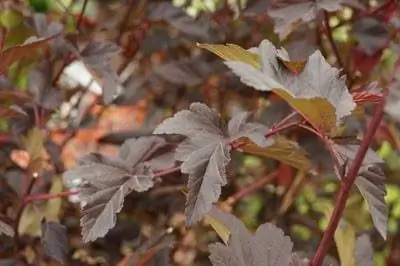
Flowering bushes like the 'Diabolo' bladderwort can be easily propagated from cuttings. All you have to do is cut off a he althy and strong shoot and put it in the ground.
You need the following utensils for propagation:
- small plastic flower pots with drain hole (diameter 6-9 cm)
- clear plastic bag
- nutrient-poor plant soil (cactus soil or growing soil)
- several cuttings
In early summer, an approximately 10 to 15 cm long piece (tip) is cut off from a one-year-old shoot (unwoody), which only has leaves but no flowers. The lower leaves are removed so that they do not rot later in the soil. The potting soil is filled into a flower pot and watered lightly. After the bark of the lower 2 cm of the cutting has been lightly scraped off with a knife, it can be inserted into the moist soil. It is important to ensure that the lowest pair of leaves has no contact with the substrate. The flower pot is now either placed in a mini greenhouse or a transparent plastic bag is placed over it to regulate the water balance. For the next three weeks, the cutting needs a bright place in the apartment, but protected from direct sun. Alternatively, the cutting can also be rooted outdoors in a partially shaded, warm spot. If the first signs of new shoots or leaves appear, this is a sign that roots have formed in the soil. The evaporation protection can now be removed. In the first year, the cutting should not overwinter outdoors, but should be kept cool but frost-free through the cold season. Next spring it will be time (from May) to plant out the young plants.
Wintering
The devil's bush is perfectly adapted to our climatic conditions and can survive even the lowest temperatures outdoors. Even in the coldest locations, it does not require any winter protection. Since the root ball of potted plants freezes easily, they should be moved to a protected location and the pot placed on a Styrofoam plate or “feet”. A thick fleece wrapped around the bucket also helps prevent it from freezing. Since the red-leaved bladderwort goes into a dormant phase in winter, it must not be kept warm over the winter.
Diseases and pests
Although Physocarpus opulifolius 'Diabolo' is not completely immune to diseases or pests, these only occur extremely rarely in the robust shrub.
Conclusion
With its dark red foliage and whitish flowers, the 'Diabolo' bladderwort is one of the most contrasting flowering shrubs in our gardens. It can be wonderfully combined with other flowering or foliage perennials and trees that have light green or white variegated foliage. The red-leaved bladderwort is very undemanding and easy to care for, is not very susceptible to diseases and is very frost hardy, so it is suitable for almost every garden and even for beginners.

